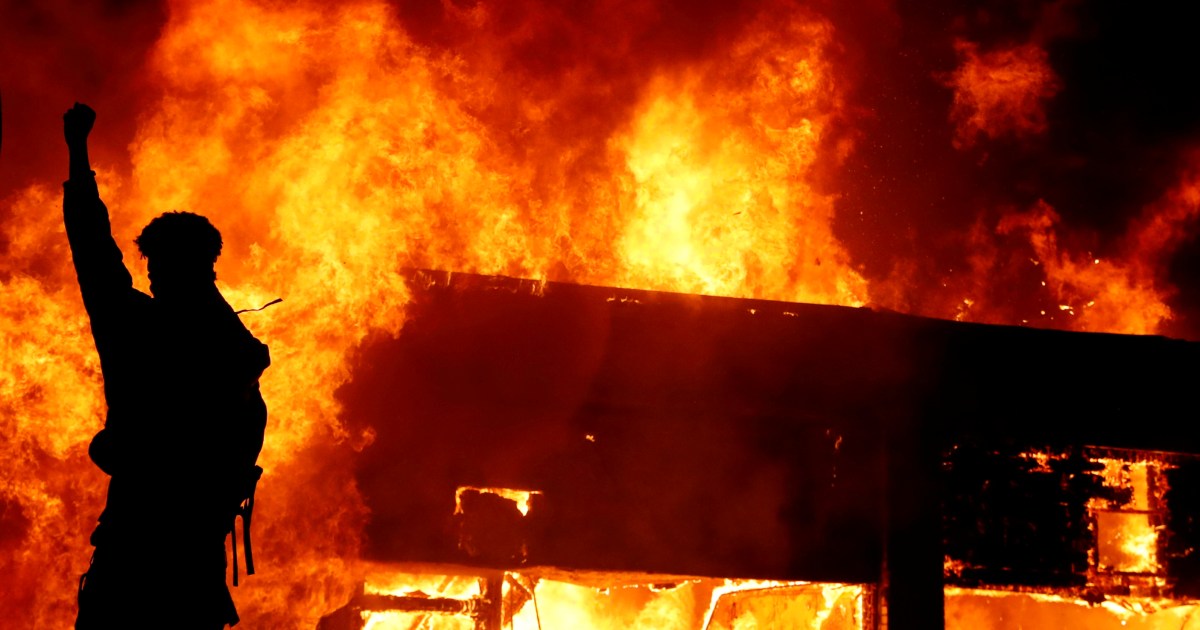At least five people were killed, and about four thousand and four hundred were detained in protests in most American cities for more than six days, after the killing of George Floyd at the hands of the police, according to the New York Times news site.
The newspaper confirmed that most of the deaths occurred in the cities of Detroit and Indianapolis, and the police leadership denied any of its members were involved in these incidents.
"The cause of these deaths is not yet clear," Indianapolis police spokesman Michael Hewitt said in a press statement. "There is no way to link these deaths - at the moment - with any kind of protests or anything, we do not know if they are separate incidents or not," he added.
Social media pioneers in the United States traded video clips of a policeman lifting a firearm against protesters in Manhattan, New York, and he did not appear to have shot him.
Tens of thousands of protesters took to the streets across the country - Sunday - as the unrest from Philadelphia to Los Angeles overshadowed peaceful demonstrations against police killing blacks.
Hundreds of protesters have gathered around the White House in Washington, DC, since Saturday evening, chanting slogans such as "Justice for Floyd", "No peace without justice", "I cannot breathe" and "Black lives matter."
Thousands of National Guard soldiers deployed, imposed a curfew in Washington, and closed mass transit systems to slow down the movement of protesters, but this did little to prevent chaos in many cities.
Protests
All of the United States of America have been witnessing protests against Floyd’s killing, since last Tuesday, and sometimes turn violent incidents between protesters and the police.
Luxury stores in Santa Monica were looted on a popular pedestrian street, before the police intervened and arrested some people. The sabotage came in the wake of a largely peaceful demonstration earlier in the coastal city.
Going south in the Los Angeles suburb of Long Beach, a group of young men and women shattered the windows of a mall and looted shops, then dispersed before a 6 p.m. curfew began.
Sporadic violence erupted in Boston after peaceful demonstrations, when activists threw bottles at police and set a vehicle on fire.
Philadelphia announced a curfew from six in the evening to six in the morning, a day after the protests and looting.
He organized a few hundred marches in central Miami, chanting chants of "No peace without justice", and the march passed near a detention center whose guests were seen from the narrow windows waving their shirts.
Last Monday, US Minneapolis police arrested Floyd on suspicion of fraud, and during his arrest a policeman placed his knee on his neck while he was in detention.
After that, Floyd appealed to the policeman to remove his knee from his neck, saying "I can't breathe," but his appeals were not answered. After the ambulance team arrived, Floyd was taken to hospital, and he died soon.
Targeting journalists
A number of journalists were assaulted or arrested, and witnesses immediately followed Friday the arrest of CNN's correspondent, Omar Khomeini, and his crew while they were being arrested live while covering a protest in the wake of Floyd’s killing in Minneapolis.
On Saturday, as protesters clashed with police across the country, Caitlin Rust, a reporter from Radio Station in Louisville, Kentucky, shouted: "I am getting beaten up, I am beaten up." Cameras filmed her when the local police were targeting her and her team, with pepper balls, at close range.
During a three-day period, institutions that track the violence targeting the press documented about 24 acts of violence, including an incident that occurred Saturday evening in Minneapolis, in which Julio Cesar Chavez, a Reuters journalist, was injured, and Rodney Seward, security advisor to Reuters, was shot dead.
Some media experts said that what appeared to be isolated attacks on the press in political rallies and protests from Los Angeles to Minneapolis to New York during the past few years had become more acute as confidence in the media diminished, approaching the lowest levels in ten years.
Truck
Yesterday, a tanker truck attempted to force its way between a procession of thousands of demonstrators at the Central Minneapolis Bridge in Minnesota, which required a large number of police officers to intervene.
The local police said - in a statement - that no injuries were likely recorded among the demonstrators, describing what happened as a "very disturbing" incident.
The truck driver was wounded, but his life was not in danger, he was taken to a hospital, and then arrested.
Minnesota Governor Tim Walls told a press conference that the driver would face criminal prosecutions, adding, "Until this hour, we do not know his motives," given that the situation could have been dramatic.
He added that the truck "appeared to contain a flammable or toxic substance (...)", describing the absence of tragedy or death toll as "unbelievable."
Dozens of police cars arrived quickly and removed the protesters from the bridge. But hundreds of them remained around. When the curfew came into effect at 8 pm, policemen threw sound bombs in an attempt to disperse them.

